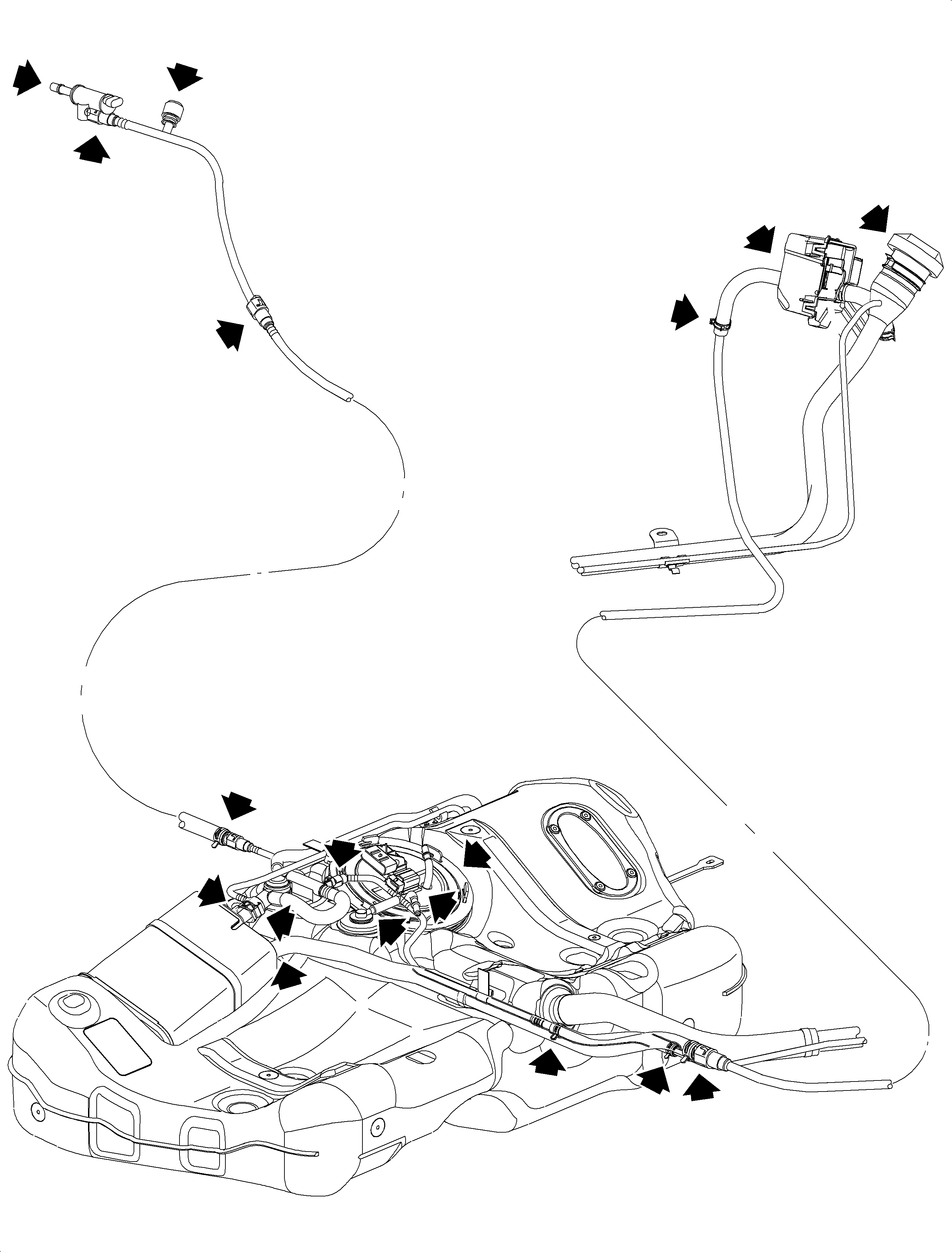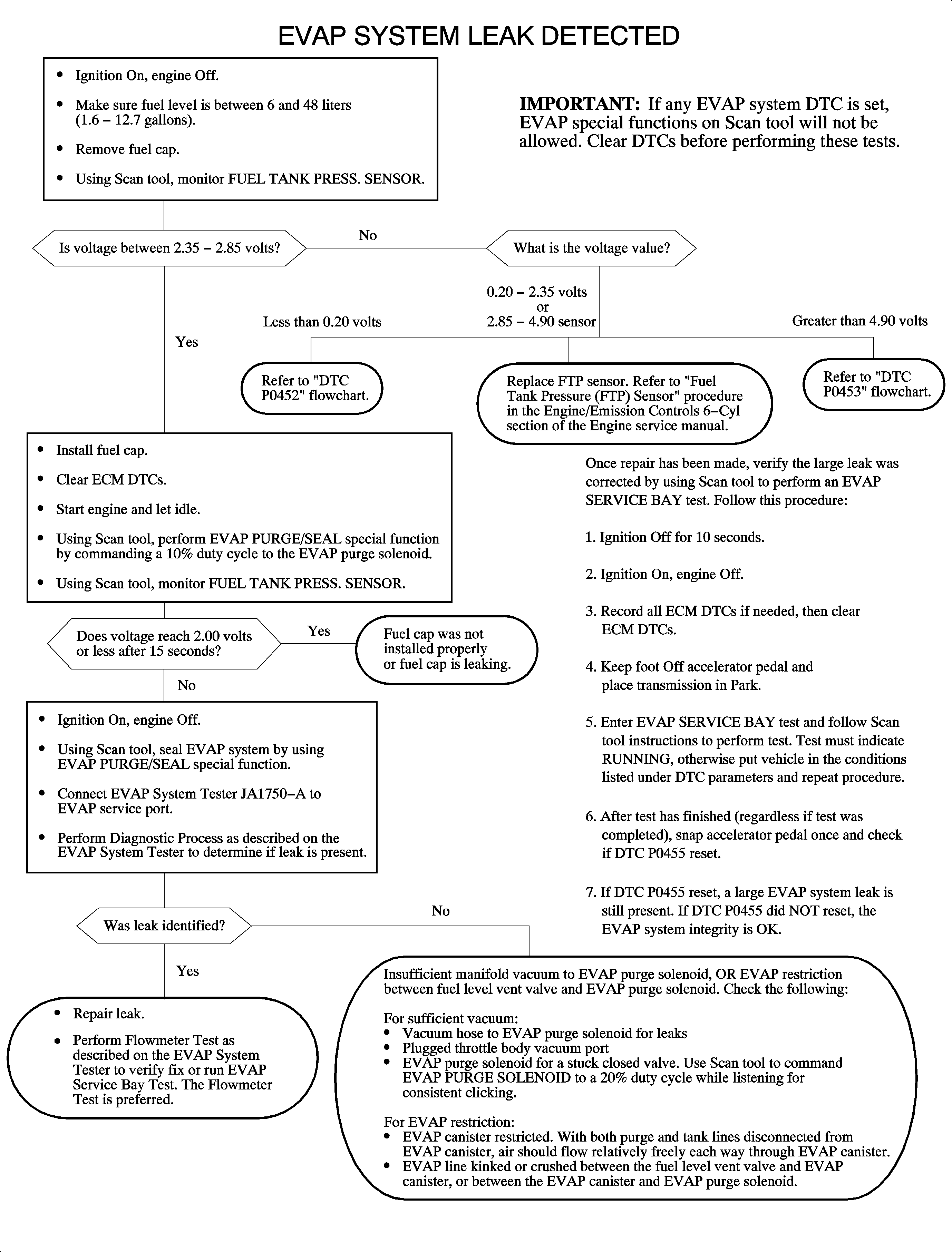Circuit Description
The evaporative emission (EVAP) system is used to store fuel vapors as to reduce
the amount of unburned fuel from escaping into the atmosphere. The EVAP system consists
of the EVAP canister, fuel tank pressure (FTP) sensor, EVAP lines and hoses, EVAP
purge solenoid - normally closed, EVAP service port, EVAP vent solenoid -
normally open, and the fuel tank. The ECM monitors the EVAP system for circuit faults
in the EVAP purge solenoid, EVAP vent solenoid, and FTP sensor circuits. The ECM also
monitors the EVAP system for leaks between the EVAP vent and EVAP purge solenoid.
When certain conditions have been met, the ECM will perform an EVAP diagnostic test
at idle with no vehicle speed, which will require a 5 consecutive Phase A,
B, C, D, and E test. DTC P0445 will set if a vacuum can not be pulled on the
EVAP system during Phase D of the EVAP diagnostic system test indicating a
large EVAP system leak or insufficient vacuum to the EVAP purge solenoid.
Conditions for Setting the DTC
DTC P0455 will set if fuel tank pressure cannot be pulled lower than
2.02 volts, -4.50 mm Hg (-2.41 in H2O)
during Phase D of the EVAP diagnostic system test indicating a large EVAP leak
when:
| • | The condition exists for 15 seconds or no change is detected for
4 seconds. |
| • | The EVAP purge solenoid is commanded to a 20 percent duty cycle. |
| • | The EVAP vent solenoid is commanded ON. |
| • | The vehicle speed is 0 mph. |
| • | The engine load less than 35 percent. |
| • | The MAP is less than 40 kPa. |
| • | The battery voltage is greater than 11 volts. |
| • | The startup ECT is between 8-75°C (46-167°F). |
| • | The IAT is between 8-50°C (46-122°F). |
| • | The long term fuel trim cells are learned. If not learned, the engine
must run longer than 16 minutes and 45 seconds. |
| • | The fuel level is between 6-48 L (1.6-12.7 gallons). |
| | No ECT, EVAP purge solenoid, EVAP vent solenoid, fuel tank pressure, idle speed,
HO2S, throttle actuator, TP sensor, or vehicle speed DTCs have been set. |
DTC P0455 diagnostic runs once during Phase D of the EVAP diagnostic
test once per ignition cycle.
If an EVAP diagnostic test is aborted due to changing enable criteria, the ECM
will attempt to rerun the EVAP diagnostic test up to 3 times per ignition cycle.
DTC P0455 is a type B DTC.
Diagnostic Aids
Important:
| • | If any EVAP system DTC is set, EVAP special functions on the scan tool
will not be allowed. Clear the DTCs before performing these tests. |
| • | The ECM uses the fuel tank pressure sensor to detect the pressure of fuel
vapor in the fuel tank during all parts of the EVAP diagnostic system test. Make sure
the fuel tank pressure sensor is not skewed by verifying FUEL TANK PRESS. SENSOR on
the scan tool is between 2.35-2.85 volts with the ignition ON and the
engine OFF and the fuel cap removed. |
Make a visual inspection for a large leak of the EVAP system. Use the EVAP System
Tester to locate the large leak. Follow operating instructions in the EVAP system
description at the end of this section.
Refer to EVAP System Description procedure at the end of this section for a
complete EVAP diagnostic test description.
Possible causes of a large EVAP leak:
| • | Fuel cap missing, incorrectly installed, or leaking |
| • | EVAP vent solenoid valve stuck open |
| • | EVAP purge solenoid stuck closed/blocked or lack of manifold vacuum to
solenoid |
| • | EVAP line/hose connections disconnected/leaking |
| • | Fuel sender O-ring leaking |
| • | Fuel tank pressure sensor seal leaking |
USE THE FOLLOWING EVAP SYSTEM PICTURE, WHICH WILL POINT TO POSSIBLE LEAK AREAS.




